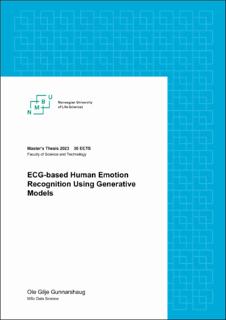ECG-based Human Emotion Recognition Using Generative Models
Master thesis
Permanent lenke
https://hdl.handle.net/11250/3079274Utgivelsesdato
2023Metadata
Vis full innførselSamlinger
- Master's theses (RealTek) [1722]
Sammendrag
Human emotion recognition (HER) is ever-evolving and has become an important research field. In autonomous driving, HER can be vital in developing autonomous vehicles. Introducing au- tonomous vehicles is expected to increase safety, having the potential to prevent accidents. Recognizing the passengers’ emotional reactions while driving can help machine learning al- gorithms learn human behavior in traffic. In this thesis, the focus has been on HER using electrocardiogram (ECG) data. The effect of Autoencoders and Sparse Autoencoders in HER using ECG data has been explored and compared to the state-of-the-art. Additionally, the extent of ECG data as a single modality for HER has been discussed. Three pipelines were con- structed to explore how Autoencoders and Sparse Autoencoders affect HER. All pipelines were denoised and resampled using the Pan-Tompkins algorithm. Additionally, the pipelines were all trained, validated, and tested using the Support Vector Classifier (SVC). The first pipeline uses the Pan-Tompkins processed signals as input to the SVC. In the second pipeline, the input to the SVC is features extracted from the signals using an Autoencoder. The last pipeline uses the latent space of a Sparse Autoencoder as input to the SVC. The target emotions for the classifi- cation task were based on the two-dimensional emotion model of valence and arousal, resulting in four classes. The pipeline including an Autoencoder for feature extraction outperformed the pipeline without feature extraction in addition to reducing the bias the models showed towards one class. Using a Sparse Autoencoder, the overall results were lower, but it was able to reduce the bias toward one class further. These results show that the Autoencoder has potential in ECG-based HER and could contribute to the field.
